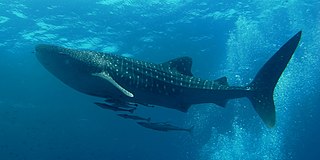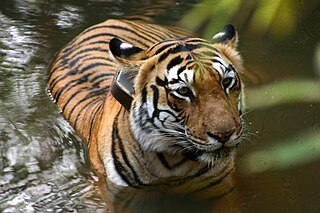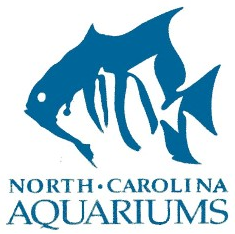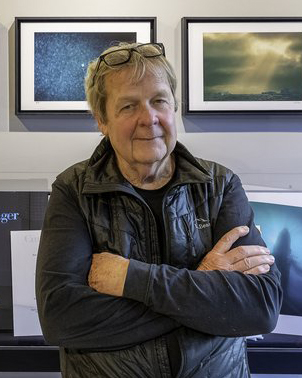Related Research Articles

The whale shark is a slow-moving, filter-feeding carpet shark and the largest known extant fish species. The largest confirmed individual had a length of 18.8 m (61.7 ft). The whale shark holds many records for size in the animal kingdom, most notably being by far the most massive living non-mammalian animal. It is the sole member of the genus Rhincodon and the only extant member of the family Rhincodontidae, which belongs to the subclass Elasmobranchii in the class Chondrichthyes. Before 1984 it was classified as Rhiniodon into Rhinodontidae.

Shedd Aquarium is an indoor public aquarium in Chicago. Opened on May 30, 1930, the 5 million US gal aquarium holds about 32,000 animals and is the third largest aquarium in the Western Hemisphere, after the Georgia Aquarium and Monterey Bay Aquarium.

Georgia Aquarium is a public aquarium in Atlanta, Georgia, United States. It exhibits hundreds of species and thousands of animals across its seven major galleries, all of which reside in more than 11 million US gallons (42,000 m3) of water. It was the largest aquarium in the world from its opening in 2005 until 2012 when it was surpassed by the S.E.A. Aquarium in Singapore and the Chimelong Ocean Kingdom in China; the Georgia Aquarium remains the largest aquarium in the United States and the fourth largest in the world.

A flipper is a broad, flattened limb adapted for aquatic locomotion. It refers to the fully webbed, swimming appendages of aquatic vertebrates that are not fish.

The Okinawa Churaumi Aquarium, formerly known as the Okinawa Ocean Expo Aquarium, is located within the Ocean Expo Park in Okinawa, Japan. It is a member of the Japanese Association of Zoos and Aquariums (JAZA), and was the largest aquarium in the world until it was surpassed by the Georgia Aquarium in 2005. The aquarium has the exhibit, "Encounter the Okinawan Sea", which reproduces the sea of Okinawa and most of the creatures that live in it. Churaumi was selected as the name of the aquarium by public vote amongst Japanese people: chura means "beautiful" or "graceful" in the Okinawan language, and umi means "ocean" in Japanese.

The New England Aquarium is a nonprofit organization located in Boston, Massachusetts. The species exhibited include harbor and northern fur seals, California sea lions, African and southern rockhopper penguins, giant Pacific octopuses, weedy seadragons, and thousands of saltwater and freshwater fishes. In addition to the main aquarium building, attractions at Central Wharf include the Simons Theatre and the New England Aquarium Whale Watch. More than 1.3 million guests visited the aquarium each year prior to the outbreak of the COVID-19 pandemic.

The loggerhead sea turtle is a species of oceanic turtle distributed throughout the world. It is a marine reptile, belonging to the family Cheloniidae. The average loggerhead measures around 90 cm (35 in) in carapace length when fully grown. The adult loggerhead sea turtle weighs approximately 135 kg (298 lb), with the largest specimens weighing in at more than 450 kg (1,000 lb). The skin ranges from yellow to brown in color, and the shell is typically reddish brown. No external differences in sex are seen until the turtle becomes an adult, the most obvious difference being the adult males have thicker tails and shorter plastrons than the females.
Mystic Aquarium is a marine aquarium in Mystic, Connecticut. It is one of only two U.S. facilities holding Steller sea lions, and it has the only beluga whales in New England. Special exhibits include the largest outdoor beluga whale habitat in the United States, a ray and shark touch pool, an African penguin exhibit, a jelly gallery, and the new Dino Seas: An Immersive Journey exhibit. The aquarium is a member of the Alliance of Marine Mammal Parks and Aquariums (AMMPA) and is an accredited member of the Association of Zoos and Aquariums (AZA). It is a subsidiary of the Sea Research Foundation, Inc.

Animal migration tracking is used in wildlife biology, conservation biology, ecology, and wildlife management to study animals' behavior in the wild. One of the first techniques was bird banding, placing passive ID tags on birds legs, to identify the bird in a future catch-and-release. Radio tracking involves attaching a small radio transmitter to the animal and following the signal with a RDF receiver. Sophisticated modern techniques use satellites to track tagged animals, and GPS tags which keep a log of the animal's location. With the Emergence of IoT the ability to make devices specific to the species or what is to be tracked is possible. One of the many goals of animal migration research has been to determine where the animals are going; however, researchers also want to know why they are going "there". Researchers not only look at the animals' migration but also what is between the migration endpoints to determine if a species is moving to new locations based on food density, a change in water temperature, or other stimulus, and the animal's ability to adapt to these changes. Migration tracking is a vital tool in efforts to control the impact of human civilization on populations of wild animals, and prevent or mitigate the ongoing extinction of endangered species.
Troy was a submarine designed by oceanographer Fabien Cousteau and engineer Eddie Paul to look like a great white shark.

The Marineland of Antibes is a theme park founded in 1970 by Count Roland de La Poype in Antibes (Alpes-Maritimes), in the French Riviera. Covering 26 hectares, it includes a marine zoological park with dolphinarium, a water park (Aquasplash), a children's play park, mini golf and a hotel. It is the property of the Spanish multinational company Parques Reunidos, whose majority shareholder is the British investment fund Arle Capital Partners. The current director is Arnaud Palu.

GPS animal tracking is a process whereby biologists, scientific researchers, or conservation agencies can remotely observe relatively fine-scale movement or migratory patterns in a free-ranging wild animal using the Global Positioning System (GPS) and optional environmental sensors or automated data-retrieval technologies such as Argos satellite uplink, mobile data telephony or GPRS and a range of analytical software tools.

Sodwana Bay is a bay in South Africa on the KwaZulu Natal north coast, between St. Lucia and Lake Sibhayi. It is in the Sodwana Bay National Park, and the Maputaland Marine Reserve, and is a popular recreational diving destination. The term is commonly used to refer to both the marine reserve and the terrestrial park, as well as the geographical bay.

Wildlife observation is the practice of noting the occurrence or abundance of animal species at a specific location and time, either for research purposes or recreation. Common examples of this type of activity are bird watching and whale watching.

The BBC Wildlife Specials are a series of nature documentary programmes commissioned by BBC Television. The series premiered in 1995, and 22 specials have been produced to date, with most of the more recent ones consisting of multiple episodes. The earlier programmes were produced in-house by the BBC's Natural History Unit, but the more recent Spy in the ... titles were made by the independent John Downer Productions. The first 18 specials, through 2008, were narrated by David Attenborough. Polar Bear: Spy on the Ice (2010), Penguins: Spy in the Huddle (2013) and Dolphins: Spy in the Pod (2014) were narrated by David Tennant.

North Carolina Aquariums is a system of three public aquariums located in Kure Beach, Roanoke Island and Pine Knoll Shores. All are operated by the Aquariums Division of the North Carolina Department of Natural and Cultural Resources since 1976 and were accredited by the Association of Zoos and Aquariums. All three aquariums feature dive shows, live animal encounters, and feeding programs.

Randall William Davis is an educator and researcher who studies the physiology and behavioral ecology of marine mammals and other aquatic vertebrates. His physiological research focuses on adaptations of marine mammals for deep, prolonged diving. Davis has continually emphasized the importance of studying aquatic animals in their natural environment and has spent many years developing animal-borne instruments that record video and monitor three-dimensional movements, swimming performance and environmental variables to better understand their behavior and ecology. His academic endeavors and 94 research expeditions have taken him to 64 countries and territories on seven continents and all of the world's oceans.

David Gruber is an American marine biologist, a Presidential Professor of Biology and Environmental Sciences at Baruch College, City University of New York, and a National Geographic Explorer.
The physiology of underwater diving is the physiological adaptations to diving of air-breathing vertebrates that have returned to the ocean from terrestrial lineages. They are a diverse group that include sea snakes, sea turtles, the marine iguana, saltwater crocodiles, penguins, pinnipeds, cetaceans, sea otters, manatees and dugongs. All known diving vertebrates dive to feed, and the extent of the diving in terms of depth and duration are influenced by feeding strategies, but also, in some cases, with predator avoidance. Diving behaviour is inextricably linked with the physiological adaptations for diving and often the behaviour leads to an investigation of the physiology that makes the behaviour possible, so they are considered together where possible. Most diving vertebrates make relatively short shallow dives. Sea snakes, crocodiles, and marine iguanas only dive in inshore waters and seldom dive deeper than 10 meters. Some of these groups can make much deeper and longer dives. Emperor penguins regularly dive to depths of 400 to 500 meters for 4 to 5 minutes, often dive for 8 to 12 minutes, and have a maximum endurance of about 22 minutes. Elephant seals stay at sea for between 2 and 8 months and dive continuously, spending 90% of their time underwater and averaging 20 minutes per dive with less than 3 minutes at the surface between dives. Their maximum dive duration is about 2 hours and they routinely feed at depths between 300 and 600 meters, though they can exceed depths of 1,600 meters. Beaked whales have been found to routinely dive to forage at depths between 835 and 1,070 meters, and remain submerged for about 50 minutes. Their maximum recorded depth is 1,888 meters, and the maximum duration is 85 minutes.

Bill Curtsinger is an American photographer and writer who publishes on underwater photography and natural history subjects. Curtsinger has photographed thirty-five articles, including six cover stories for National Geographic as well as a cover story for Life. His photos have also appeared in Smithsonian, Natural History, various scientific journals and a number of books worldwide.
References
- ↑ "Exploration Technology Lab". Archived from the original on January 31, 2011.
- ↑ Greg Marshall biography Archived 2010-01-03 at the Wayback Machine
- ↑ National Geographic Crittercam chronicles. Frequently Asked Questions Archived 2010-02-07 at the Wayback Machine
- ↑ "Exploration Technology Lab". Archived from the original on January 31, 2011.
- ↑ "Kitty Cams UGA Research". Archived from the original on 2013-11-09. Retrieved 2018-05-21.
- ↑ "Critter Cam Exhibit - National Geographic". Archived from the original on 2013-05-30. Retrieved 2012-04-24.
- Crittercam, additional feature on the March of the Penguins DVD.